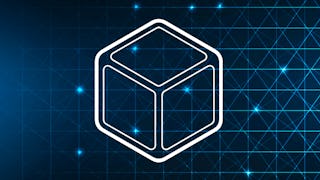Learn how the blockchain authenticates transactions and distributes data to peers — nodes connected to the network. This course shows you how multiple versions of a blockchain are reconciled into one, discusses blockchain limitations, and delves into organizational applications of blockchain technology.

Enjoy unlimited growth with a year of Coursera Plus for $199 (regularly $399). Save now.

The Blockchain System
This course is part of Blockchain Specialization

Instructor: Stefano M. Stefan
5,837 already enrolled
Included with
(40 reviews)
Skills you'll gain
Details to know

Add to your LinkedIn profile
See how employees at top companies are mastering in-demand skills

Build your subject-matter expertise
- Learn new concepts from industry experts
- Gain a foundational understanding of a subject or tool
- Develop job-relevant skills with hands-on projects
- Earn a shareable career certificate

There are 4 modules in this course
During this initial week we will start by looking at how the blockchain data are shared among nodes in the peer-to-peer network over the internet and how the interconnectivity of the nodes is managed.
What's included
1 video3 readings1 assignment1 discussion prompt
We will continue to look more closely at how nodes add blocks to the data structure with the goal of maintaining a consistent transaction history. We’ll also see that multiple histories can sometimes arise due to a variety of factors ranging from benign, but unpredictable, node outages to intentional malfeasance. This requires that the system have a means of collectively determining which single history is the correct one. We’ll explore two approaches to achieve this: the longest chain criterion and the heaviest chain criterion and practice applying the principles that we have learned in this week’s assignment.
What's included
3 readings1 peer review1 discussion prompt
The blockchain is not a perfect system and indeed has its limitations. We will explore some of the constraints of the blockchain and address the issues that cause such limitations.
What's included
1 video2 readings1 assignment1 discussion prompt
We will finish the course by exploring other opportunities for using a blockchain approach to decentralize what have been heretofore centralized industries in which individual entities have controlled or consolidated information. We will develop ideas for applying a blockchain approach to industries other than cryptofinance.
What's included
1 video2 readings1 peer review1 discussion prompt
Earn a career certificate
Add this credential to your LinkedIn profile, resume, or CV. Share it on social media and in your performance review.
Instructor

Offered by
Explore more from Algorithms
 Status: Free Trial
Status: Free TrialUniversity of California, Irvine
 Status: Free Trial
Status: Free TrialUniversity at Buffalo

Infosec
 Status: Free Trial
Status: Free Trial
Why people choose Coursera for their career




Learner reviews
40 reviews
- 5 stars
75%
- 4 stars
2.50%
- 3 stars
5%
- 2 stars
5%
- 1 star
12.50%
Showing 3 of 40
Reviewed on Jun 28, 2020
I completed my First Specialization certification.

Open new doors with Coursera Plus
Unlimited access to 10,000+ world-class courses, hands-on projects, and job-ready certificate programs - all included in your subscription
Advance your career with an online degree
Earn a degree from world-class universities - 100% online
Join over 3,400 global companies that choose Coursera for Business
Upskill your employees to excel in the digital economy
Frequently asked questions
To access the course materials, assignments and to earn a Certificate, you will need to purchase the Certificate experience when you enroll in a course. You can try a Free Trial instead, or apply for Financial Aid. The course may offer 'Full Course, No Certificate' instead. This option lets you see all course materials, submit required assessments, and get a final grade. This also means that you will not be able to purchase a Certificate experience.
When you enroll in the course, you get access to all of the courses in the Specialization, and you earn a certificate when you complete the work. Your electronic Certificate will be added to your Accomplishments page - from there, you can print your Certificate or add it to your LinkedIn profile.
Yes. In select learning programs, you can apply for financial aid or a scholarship if you can’t afford the enrollment fee. If fin aid or scholarship is available for your learning program selection, you’ll find a link to apply on the description page.
More questions
Financial aid available,
¹ Some assignments in this course are AI-graded. For these assignments, your data will be used in accordance with Coursera's Privacy Notice.

